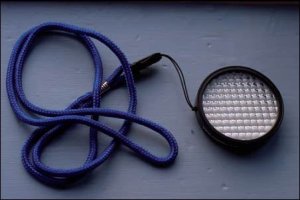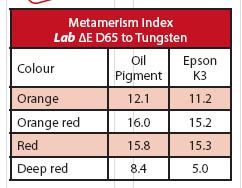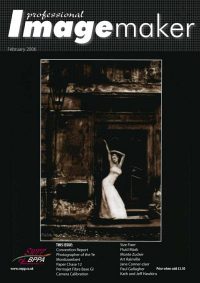articles/Cameras/cameracalibration-page2
Camera Calibration - part 2 of 1 2 3 4
by Mike McNamee Published 01/02/2006

The expodisc is available from www.flaghead.co.uk and Imagemaker www.bobrigby.com
The expodisc
The expodisc was designed by the late George A Wallace. It works by integrating all the light being received by the lens so that a more representative exposure and colour balance may be obtained. It comes with a reassuring quality control card, which informed us that our sample had a density of 0.75 compared with the aim value of 0.745 for a true 18% grey - quite accurate then!
It is equipped with a lanyard (handy on cliff tops) so that it is readily available and (also for speed) it is simply held over the lens front when in use. Various sizes are available and we tested the smallest 58mm one, about right for our 52mmthroated Nikkors.
In use, you may use the expodisc to determine both the exposure and the white balance. Alternatively you may use the expodisc to obtain the correct exposure setting, take a shot with the disc in place and then white balance in Photoshop's RAW file handler (or its equivalent, say RawShooter).
Obviously the resulting colours are influenced by the accuracy of the camera's metering and the characteristic of the individual chip. Therefore, if you find that the expodisc consistently over- or under-exposes, then you can set an exposure compensation permanently in your camera. To do this, open the plain grey exposure through the expodisc in RAW and adjust the Exposure slider until the RGB value reported in the top right is 121 points. The exposure compensation may then be read off from the box to the right.

In use, the expodisc is fast and easy - indeed when Monte Zucker demonstrated it at his seminar last year, if you blinked, you missed it! In essence it is used like an integrating incident light meter. You point it at the sun (with the expodisc in place
seemed to be behaving like belligerent sheep, unpredictable and difficult to pin down - once we got a couple of them into the pen, the others had run off! However, persevere we did, and here are the results. The metamerism errors in the Penny Warden pigments ranged from 8.4 to 16 Lab points, this against a backdrop of striving to get the actual colours within 4 Lab points! In other words the error due to lighting variation was four times the error we were shooting for. Initially we ignored the pigments so as to get our bearing on the performance over the whole gamut of the Macbeth Chart.
Corrected files were made and transferred to Photoshop for further analysis. The best exposure was adjusted for both white balance and exposure in Adobe Camera Raw placing the 18%, mid-grey swatch on 121 RGB points in the red, green and blue channels before saving as an Adobe RGB, TIFF file for the calibration software. This file was examined using five refinements:
Please Note:
There is more than one page for this Article.
You are currently on page 2
- Camera Calibration page 1
- Camera Calibration page 2
- Camera Calibration page 3
- Camera Calibration page 4
1st Published 01/02/2006
last update 09/12/2022 14:52:06
More Cameras Articles
There are 29 days to get ready for The Society of Photographers Convention and Trade Show at The Novotel London West, Hammersmith ...
which starts on Wednesday 14th January 2026





